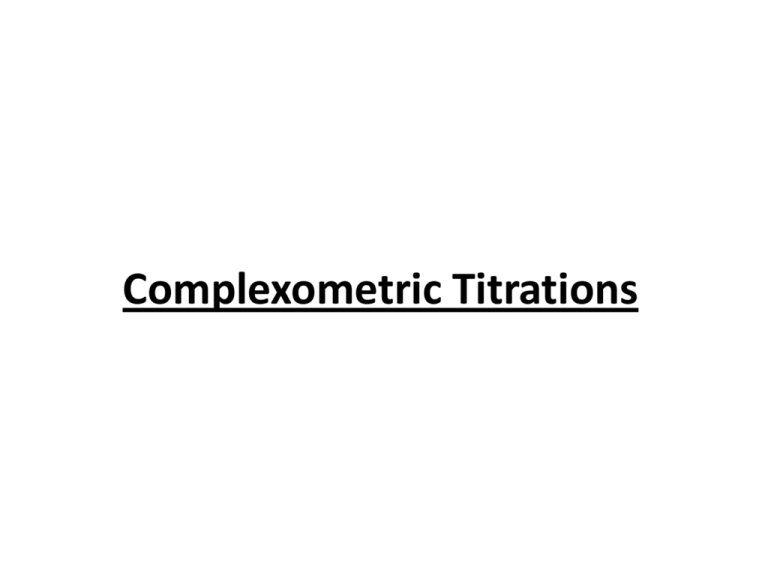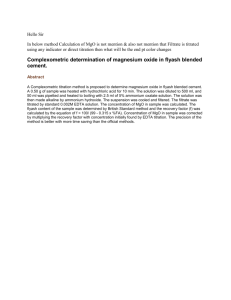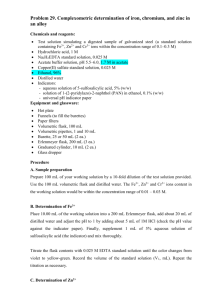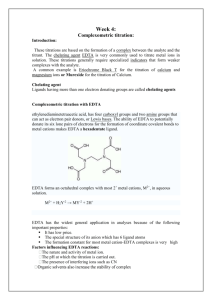Complexometric Titrations
advertisement

Complexometric Titrations Complexometric formation reaction: It is the combination of metal ion with electron donating group to form a complex. The molecule bound to the metal ion is called the ligand. The complex has different properties from that metal ion. M2+ + nL [MLn]2+ electron acceptor + electron donor (ligand) Complex The metal ion acts as Lewis acid (electron acceptor) and the ligand is used as a titrant or a complex forming agent which acts as a Lewis base (electron donor). • Although the reaction between a metal and a ligand can be considered as an acid base interaction, but it was found that metal ions cannot be titrated with simple ligands as ammonia or cyanide, because of lack of a sharp end point. Note: Complexometric titrations are only possible if: The complex formation reaction occurs in one step with a high stability constant. Factors affecting the stability of the complex: I) Ability of central metal ion to form complex II) Ability of ligand to form complex I) Ability of central metal ion to form complex 1-Acidity of Mn+: Acidity means electron accepting power As the intensity of +ve charge increases electron accepting power increases The most stable complex. 2- Ionic size: The smallest ion (radius) The greatest electric field The most stable complex. 3- Ionic charge : For ions of equal size, the one with higher charge forms more stable complex eg.: Ferricyanide [Fe(CN)6]-3 is more stable than ferrocyanide [Fe(CN)6]-4 Therefore, a large (charge/radius) ratio leads to stable complex. II) Ability of ligand to form complex: 1-Basicity of ligand: Basicity of ligand is its electron donating ability. As the basicity of ligand increase its tendency to donate electrons increase The most stable complex. Therefore ligand must contain electron donating atom. Ñ, Ŏ, Š. 2- Size of ligand: The biggest the ligand (radius) The greatest electron donating ability The most stable complex. 3- Steric effect: Large, bulky or branched ligands form less stable complexes. e.g: Ethylene diamine form more stable complex than its tetramethyl derivative. Remember that: The coordination number (n) of the metal ion represents the number of coordinate bonds around the central metal. e.g: Ag+ + 2CN[Ag(CN)2]n=2 Cu2+ + 4NH3[Cu(NH3)4]2+ n=4 Fe3+ + 6SCN[Fe(SCN)6]3n=6 Types of Ligands: According to the number of points of attachments to the metal ion 1- Monodentate Ligands: are ligands which are bound to the metal ion at only one point. Example: NH3 , CN- , FCu2+ + NH3 Cu(NH)32+ 2- Bidentate Ligands: are ligands which have two atoms, each of which has a lone pair of electrons and form two coordinate bonds with the metal ion. Example: Ehtylene diamine H2N-CH2-CH2-NH2 3- Multidentate Ligands: are ligands which contain more than two coordinating atoms per molecule. Example: Ethylene diamine tetra acetic acid (EDTA). Complexometric titration Cont. Metal Indicators These indicators are dyes that can form a soluble complex with the metal ion, resulting in a color that is different from the dye itself. The metal-dye complex must be less stable than the metal-EDTA complex. MgIn- + H2Y2MgY2- + HIn2- + H+ Indicator complex free indicator Eriochrome black T(E.B.T) This indicator is blue at about pH 10 (using ammonia buffer) and most of its complexes are reddish. It is used at pH 10 for the determination of Ca2+, Mg2+, Zn2+ , Cd2+. E.P: : wine red blue. Structure of E.B.T indicator (free indicator is blue) MurexideMurexide This indicator is violet at pH 12 (using 8% NaOH) and most of its complexes are reddish. Since magnesium-murexide is less stable than the calcium- murexide, murexide indicator can be used for the determination of calcium in presence of magnesium. Structure of murexide indicator (free indicator is violet) E.P: red violet EDTA Titration Methods 1.Direct titration 2. Back titration 3. Replacement or Substitution titration 4. Alkalimetric titration 5. Miscellaneous methods • 1.Direct titration: The solution containing the metal ion to be determined is buffered to the desired pH (e.g. to pH 10 with ammonia buffer) and titrated directly with the standard EDTA solution. At the equivalent point, the concentration of the metal ion being determined decreases abruptly. This is generally, dtermined by the change in the colour of a metal indicator. 2. Back titration: Many metals can’t be titrated directly; because: 1) They may precipitate from the solution in the pH of the titration such as Aluimium forms hydroxide 2) They may form inert complexes with the indicator 3) There is no suitable metal indicator available. An excess standard EDTA solution is added, the resulting solution is buffered to the desired pH, and the excess EDTA is back titrated with a standard metal ion solution (ZnCl2 or ZnSO4 or MgCl2 or MgSO4). The end point is detected with the metal indicator colour which responds, to the zinc or magnesium ions introduced in the back titration. 3. Replacement or Substitution titration: Used for: 1) Metal ions that do not react (or react unsatisfactory) with a metal indicator, 2) Sharp end point is not obtained. This method is suitable for metal ions which form EDTA complexes that are more stable than those of other metals such as magnesium and calcium. The metal cation Mn+ to be determined may be treated with the magnesium complex of EDTA, where the following reaction occurs: Mn+ + MgY2MY2- + Mg2+ The amount of free magnesium ion is equivalent to the metal present and can be titrated with a standard solution of EDTA and a suitable metal indicator. Example: In the direct titration of calcium ions, E.B.T gives poor end point; if magnesium is present, it is displaced from its EDTA complex by calcium and an improved end point results. Ca2+ + MgY2MY2- + Mg2+ 4. Alkalimetric titration: When a solution of disodium ethylenediaminetetraacetate, Na2H2Y, is added to a solution containing metallic ions, complexes are formed with the liberation of two equivalents of hydrogen ions: M2+ + H2Y2- MY2- + 2H+ The free hydrogen ions can be titrated with a standard solution of sodium hydroxide using an acid base indicator. The solution of the metal to be determined must be accurately neutralized before titration. 5. Miscellaneous methods: Exchange reactions between the tetracyanonickelate(II) ions [Ni(CN)4]2- and the element to be determined, where nickel ions are set free. Thus silver and gold, which themselves can’t be titrated complexometrically, can be determined in this way. [Ni(CN)4]2- + 2 Ag+ 2 [Ag(CN)2]- + Ni2+ Kcomplex stability EDTA Titration Curve pM Sample: 0.01M Metal (M) Titrant: 0.01M EDTA What we need? Draw the titration curve i.e. plot the .1 volume of EDTA added versus CALCULATED pM 2. Estimate the End Point 3. Select the suitable indicator 4. What did you understand from the shape i.e. stable of the curve (inflexion) or unstable complex at the giving pH?????? 1016 16 14 12 1010 10 8 106 6 104 4 2 2 4 6 8 10 12 0.01M EDTA, mL 20 • Titration curves for 0.1 M Ca2+ versus 0.1 M EDTA at pH 7 and pH 10 are shown in Figure 4. This figure indicates the effect of pH on apparent stability constants and correspondingly on the shape of the titration curve. More Stable pCa More inflexion Less Less Stable inflexion mL EDTA Fig.4: Titration curves of Ca2+ with EDTA at pH 7 and pH 10. 22 Titration of Mixtures, Selectivity, Masking and Demasking Agents EDTA is a very unselective reagent because it complexes with many divalent, trivalent, tetravalent cations. The following procedures will help to increase the selectivity a) Suitable control of the pH of the solution: • Bismuth Bi3+ and Th4+ can be titrated in an acidic solution (pH=2) with xylenol orange as indicator and most divalent cations don’t interfere. • A mixture of bismuth and lead ions can be successfully titrated by first titrating the bismuth at pH 2 with xylenol orange as indicator, and then adding hexamine to raise the pH to about 5, and titrating the lead. Q. How to analyse a mixture of Bismuth and Lead? A: By suitable control of the pH: by titrating Bi3+ # EDTA at pH 2 with X.O as indicator and then adding hexamine to raise pH to 5 and titrate Pb2+ # EDTA. b) Use of masking agents: Masking: Means a process in which a substance, without physical separation, is transformed that it does not enter into a particular reaction. Demasking: It is a process in which the masked substance regains its ability to enter a particular reaction. By the use of masking agents, some of the cations in a mixture can often be masked, so they can no longer react with EDTA or with the indicator. Example of masking agent is the cyanide ion; which forms very stable cyanide complex with Cd2+, Zn2+, Hg2+, Cu2+, Co2+, Ni2+, Ag+, Pt, whereas, manganese and lead form weak complex, meanwhile Ca2+, Mg2+ do not form complex at all with cyanide. M2+ + CN[M (CN)4]2It’s possible to determine cations such as Ca2+, Mg2+, Pb2+, and Mn2+ in presence of the above mentioned metals by masking with an excess of potassium or sodium cyanide. c) Selective demasking The cyanide complexes of zinc and cadmium may be demasked with formaldehyde-acetic acid solution, which will give Zn2+ & Cd2+free again. [Zn(CN)4]2-+ 4H+ +4HCHO Zn2++ HO.CH2.CN A solution containing Mg2+, Zn2+ and Cu2+ can be titrated as follows: 1- By back titration # standard Mg2+ solution using E.B.T as indicator Total metals.(1) 2- Treat another portion with excess KCN and titrate # EDTA Mg2+ (2) 3- Add excess of formaldehyde-acetic acid solution to the above titrated solution in order to liberate Zn2+ from the cyanide complex, and titrate with EDTA tell the indicator turns blue Zn2+ only. (3) 4- Cu2+ content can be found by difference. Q. How to analyse a mixture of Mg2+, Zn2+ and Cu2+? How to analyse a mixture of Ca2+ and Mg2+? 1- By titration # EDTA in ammonia buffer with E.B.T as indicator total. 2- By titration another portion # EDTA in 8% NaOH with murexide indicator Ca2+ only. Q. How to increase selectivity of EDTA? هام By control pH and masking & demasking, with examples. نشرح االمثله • Titrations involving unidentate ligands 1- Cyanometric titrations Liebeg's & Denige’s method • 2- Mercurimetric titrations • 1- Cyanometric titrations (AgNO3 titrant) • Liebeg's method + Ag + 2CN - Ag+ + Ag(CN)2- - Ag(CN)2 Ag[Ag(CN)2] Deniges modification of Liebeg’s method Indicator: IEP: AgI • 2- Mercurimetric titrations (Hg(NO3)2 titrant) • 4I- + Hg2+ = (HgI4)2• (HgI4)2- + Hg2+ = 2 HgI2 Yes I do not know No Mark(√) for the correct statement and (x) for the wrong one • EDTA is used as a precipitating agent for metal ions (N) • Coordination numbers of EDTA with Cu2+ at pH 10.0 is equal to three (N) • Copper-EDTA complex is more stable than copper ammine complex (Y) • More coordination number the more stable complex (Y) • Only one ionization form of EDTA at pH 13. (Y) • EDTA chemically is considered as strong acid. (N) • Metal:EDTA complex ratio is 1:1 Stoichiometry (Y) • The stability EDTA – Metal complexes are sensitive to pH change. (Y) • The apparent Stability constant of EDTA is considered one at pH 13. (Y) • Cd-EDTA complex is more stable at pH 2 than pH 11 (N). 32







